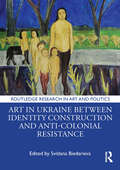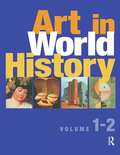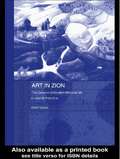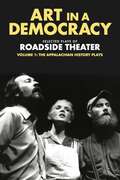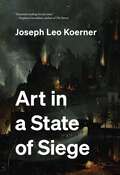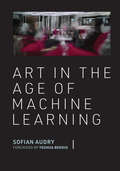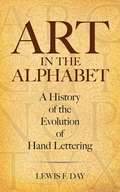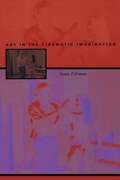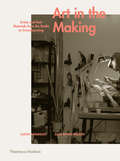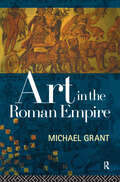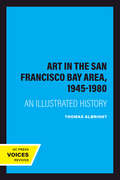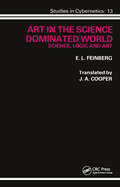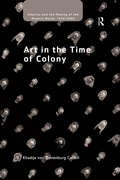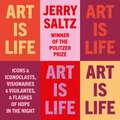- Table View
- List View
Art in Ukraine Between Identity Construction and Anti-Colonial Resistance (Routledge Research in Art and Politics)
by Svitlana BiedarievaThis edited volume traces the development of art practices in Ukraine from the 2004 Orange Revolution, through the 2013–2014 Revolution of Dignity, to the ongoing Russian war of aggression.Contributors explore how transformations of identity, the emergence of participatory democracy, relevant changes to cultural institutions, and the realization of the necessity of decolonial release have influenced the focus and themes of contemporary art practices in Ukraine. The chapters analyze such important topics as the postcolonial retrieval of the past, the deconstruction of post-Soviet visualities, representations of violence and atrocities in the ongoing Russian war against Ukraine, and the notion of art as a mechanism of civic resistance and identity-building.The book will be of interest to scholars of art history, Eastern European studies, cultural studies, decolonial studies, and postcolonial studies.
Art in World History 2 Vols
by HollingsworthA guide to the establishment of the library which covers materials acquisition, the organization and usage of the library's collection to provide a variety of services and the use of automation. This book aims to instruct the librarian on managing the small library effectively.
Art in Zion: The Genesis of Modern National Art in Jewish Palestine (Routledge Jewish Studies Series)
by Dalia ManorArt in Zion deals with the link between art and national ideology and specifically between the artistic activity that emerged in Jewish Palestine in the first decades of the twentieth century and the Zionist movement. In order to examine the development of national art in Jewish Palestine, the book focuses on direct and indirect expressions of Zionist ideology in the artistic activity in the yishuv (the Jewish community in Palestine). In particular, the book explores two major phases in the early development of Jewish art in Palestine: the activity of the Bezalel School of Art and Crafts, and the emergence during the 1920s of a group of artists known as the Modernists.
Art in a Democracy: Selected Plays of Roadside Theater, Volume 1: The Appalachian History Plays, 1975–1989
by Ben FinkSeminal plays and essays reveal the radical origins and approach of Appalachia’s Roadside TheaterThis two-volume anthology tells the story of Roadside Theater’s first 45 years and includes nine award-winning original play scripts; ten essays by authors from different disciplines and generations, which explore the plays’ social, economic, and political circumstances; and a critical recounting of the theater’s history from 1975 through 2020. The plays in Volume 1 offer a people’s history of the Appalachian coalfields, from the European incursion through the American War in Vietnam.
Art in a Democracy: Selected Plays of Roadside Theater, Volume 2: The Intercultural Plays, 1990–2020
by Ben FinkCollaborative plays with diverse ensembles across the country address pressing issues of our timesThe plays in Volume 2 come from Roadside’s intercultural and issue-specific theater work, including long-term collaborations with the African American Junebug Productions in New Orleans and the Puerto Rican Pregones Theater in the South Bronx, as well as with residents on both sides of the walls of recently-built prisons. Roadside has spent 45 years searching for what art in a democracy might look like. The anthology raises questions such as, What are common principles and common barriers to achieving democracy across disciplines, and how can the disciplines unite in common democratic cause?
Art in a State of Siege
by Joseph Leo KoernerAn art historical epic for dangerous timesWhat do artworks look like in extreme cases of collective experience? What signals do artists send when enemies are at the city walls and the rule of law breaks down, or when a tyrant suspends the law to attack from inside? Art in a State of Siege tells the story of three compelling images created in dangerous moments and the people who experienced them—from Philip II of Spain to Carl Schmitt—whose panicked gaze turned artworks into omens.Acclaimed art historian Joseph Koerner reaches back to the eve of iconoclasm and religious warfare to explore the most elusive painting ever painted. In Hieronymus Bosch&’s Garden of Delights, enemies are everywhere: Jews and Ottomans at the gates, witches and heretics at home, sins overtaking the mind. Following a paper trail leading from Bosch&’s time to World War II, Koerner considers a monumental self-portrait painted by Max Beckmann in 1927. Created when Germany was often governed by emergency decree, this image brazenly claimed to decide Europe&’s future—until the Nazis deemed it to be a threat to the German people. For South African artist William Kentridge, Beckmann exemplified &“art in a state of siege.&” Koerner shows how his work served as beacon during South Africa&’s racialist apartheid rule and inspired Kentridge&’s breakthrough animations of drawings being made, erased, and remade.Spanning half a millennium but urgent today, Art in a State of Siege reveals how, in dire straits, art becomes the currency of last resort.
Art in the Age of Machine Learning (Leonardo)
by Sofian AudryAn examination of machine learning art and its practice in new media art and music. Over the past decade, an artistic movement has emerged that draws on machine learning as both inspiration and medium. In this book, transdisciplinary artist-researcher Sofian Audry examines artistic practices at the intersection of machine learning and new media art, providing conceptual tools and historical perspectives for new media artists, musicians, composers, writers, curators, and theorists. Audry looks at works from a broad range of practices, including new media installation, robotic art, visual art, electronic music and sound, and electronic literature, connecting machine learning art to such earlier artistic practices as cybernetics art, artificial life art, and evolutionary art. Machine learning underlies computational systems that are biologically inspired, statistically driven, agent-based networked entities that program themselves. Audry explains the fundamental design of machine learning algorithmic structures in terms accessible to the nonspecialist while framing these technologies within larger historical and conceptual spaces. Audry debunks myths about machine learning art, including the ideas that machine learning can create art without artists and that machine learning will soon bring about superhuman intelligence and creativity. Audry considers learning procedures, describing how artists hijack the training process by playing with evaluative functions; discusses trainable machines and models, explaining how different types of machine learning systems enable different kinds of artistic practices; and reviews the role of data in machine learning art, showing how artists use data as a raw material to steer learning systems and arguing that machine learning allows for novel forms of algorithmic remixes.
Art in the Alphabet: A History of the Evolution of Hand Lettering
by Lewis F. DayThis grand compilation presents more than 250 depictions of the alphabet's changing forms, from handsome Roman letters cut in marble and delicate English courthand to sixteenth-century Greek initials and modern styles inspired by Gothic, Japanese, and other forms of writing. In addition to its intriguing survey of historical trends, this book also offers richly illustrated reflections on the artistic ability involved in rendering the alphabet. An introductory essay traces the evolution of the English alphabet, followed by a wealth of old alphabets arranged in order of date. Among the selection of modern alphabets are samples that offer evidence of how the surface — wood, stone, leather, mosaic — and the writing instrument — chisel, needle, brush, stylus, pen — can affect the character of the lettering. An assortment of ampersands and numerals concludes the volume, along with an index of illustrations arranged by artist, country, material and process, and style. Artists, graphic artists, historians, and anyone with an interest in calligraphy will appreciate the historic sweep and artistic range of this treasury of lettering.
Art in the Cinematic Imagination
by Susan FellemanBringing an art historical perspective to the realm of American and European film, "Art in the Cinematic Imagination" examines the ways in which films have used works of art and artists themselves as cinematic and narrative motifs.
Art in the City, the City in Art (The Contemporary City)
by Elisha MasemannThis Book examines an interplay between discourses on the city that stress the need for rational-functional order and art’s imaginative deviations from the topdown structures of urban life. Moving between theory and praxis, the book situates the city as both a concept and physical construct through which lives and possibilities are shaped or defined. In response, certain modalities of art create spontaneous, non-rational and playful interludes that risk escape from the urban apparatus and a hyper-valorisation of rational order. A three-part framework is used to discuss this push-pull dynamic and to assess the strategies of shock, performative embodiment and intervention that emerged in post-war art movements and in contemporary performance and participatory art practices. The book examines how the disturbances introduced by artists throw the city construct into sharp relief, making it visible and activating momentary encounters where new modes of expression can emerge. This Book offers a new approach to interdisciplinary studies of art and urbanity. The book aims to delineate how the city—as concept and construct—is made visible through artistic practice and in turn challenged or interrogated. Students, researchers and professionals with an interest in the interaction between art and urban studies will discover a new perspective on how urban conditions and issues have been addressed through artistic practice. The book contributes to an evolving discourse in the urban humanities through an exposition of the city’s default construct that is made visible or reimagined through visual art in public spaces.
Art in the Making: Artists and their Materials from the Studio to Crowdsourcing
by Julia Bryan-Wilson Glenn AdamsonThe first book to address the significance of the materials and methods used to make contemporary artworks Today, artists are able to create using multiple methods of production--from painting to digital technologies to crowdsourcing--some of which would have been unheard of just a few decades ago. Yet, even as our means of making art become more extraordinary and diverse, they are almost never addressed in their specificity. While critics and viewers tend to focus on the finished products we see in museums and galleries, authors Glenn Adamson and Julia Bryan-Wilson argue that the materials and processes behind the scenes used to make artworks are also vital to current considerations of authorship and to understanding the economic and social contexts from which art emerges. This wide-ranging exploration of different methods and media in art since the 1950s includes nine chapters that focus on individual processes of making: Painting, Woodworking, Building, Performing, Tooling Up, Cashing In, Fabricating, Digitizing, and Crowdsourcing. Detailed examples are interwoven with the discussion, including visuals that reveal the intricacies of techniques and materials. Artists featured include Ai Weiwei, Alice Aycock, Isa Genzken, Los Carpinteros, Paul Pfeiffer, Doris Salcedo, Santiago Sierra, and Rachel Whiteread.
Art in the Roman Empire
by Michael GrantMichael Grant has specially selected some of the most significant examples of painting, portraits, architecture, mosaic, jewellery and silverware, to give a unique insight into the functions and manifestations of art in the Roman Empire. Art in the Roman Empire shows how many of the most impressive masterpieces were produced outside Rome, on the frontiers of its enormous empire.
Art in the San Francisco Bay Area, 1945-1980: An Illustrated History
by Thomas AlbrightThis title is part of UC Press's Voices Revived program, which commemorates University of California Press’s mission to seek out and cultivate the brightest minds and give them voice, reach, and impact. Drawing on a backlist dating to 1893, Voices Revived makes high-quality, peer-reviewed scholarship accessible once again using print-on-demand technology. This title was originally published in 1985.This title is part of UC Press's Voices Revived program, which commemorates University of California Press’s mission to seek out and cultivate the brightest minds and give them voice, reach, and impact. Drawing on a backlist dating to 1893, Voices Revived</DIV
Art in the Science Dominated World: Science, Logic and Art
by E. L. FeinbergThe subject of cybernetics is quickly growing and there now exists a vast amount of information on all aspects of this broad-based set of disciplines. This book concerns the phenomenon of art and the special problems that arise concerning art in our era which is almost unanimously regarded as unique, as the era when science and technology have, as never before, become the influence on human society. The aim of this book is to consider the two ways of perception and cognition of the world, two kinds and trends of man’s spiritual life in their interrelation
Art in the Time of Colony (Empire and the Making of the Modern World, 1650-2000)
by Khadija von CarrollIt is often assumed that the verbal and visual languages of Indigenous people had little influence upon the classification of scientific, legal, and artistic objects in the metropolises and museums of nineteenth-century colonial powers. However colonized locals did more than merely collect material for interested colonizers. In developing the concept of anachronism for the analysis of colonial material this book writes the complex biographies for five key objects that exemplify, embody, and refract the tensions of nineteenth-century history. Through an analysis of particular language notations and drawings hidden in colonial documents and a reexamination of cross-cultural communication, the book writes biographies for five objects that exemplify the tensions of nineteenth-century history. The author also draws on fieldwork done in communities today, such as the group of Koorie women whose re-enactments of tradition illustrate the first chapter’s potted history of indigenous mediums and debates. The second case study explores British colonial history through the biography of the proclamation boards produced under George Arthur (1784-1854), Governor of British Honduras, Tasmania, British Columbia, and India. The third case study looks at the maps of the German explorer of indigenous taxonomy Wilhelm von Blandowski (1822-1878), and the fourth looks at a multi-authored encyclopaedia in which Blandowski had taken into account indigenous knowledge such as that in the work of Kwat-Kwat artist Yakaduna, whose hundreds of drawings (1862-1901) are the material basis for the fifth and final case study. Through these three characters’ histories Art in the Time of Colony demonstrates the political importance of material culture by using objects to revisit the much-contested nineteenth-century colonial period, in which the colonial nations as a cultural and legal-political system were brought into being.
Art is Life: Icons & Iconoclasts, Visionaries & Vigilantes, & Flashes of Hope in the Night
by Jerry Saltz"The world's most famous and celebrated contemporary art critic." -GQ"One of the most powerful art critics today." -Time Out"Senior art critic and columnist for New York magazine, Jerry Saltz is as influential as they come. He demystifies the art world in refreshing plain speak and his latest book, focusing on the two decades since 9/11, promises to be another must-listen." - Irish Times From the Pulitzer Prize winner and bestselling author of How to Be an Artist, a deliciously readable survey of the art world in turbulent times. Jerry Saltz is one of our most-watched writers about art and artists, and a passionate champion of the importance of art in our shared cultural life. Since the 1990s he has been an indispensable cultural voice: witty and provocative, he has attracted contemporary readers to fine art as few critics have.Now, in Art Is Life, Jerry Saltz draws on two decades of work to offer a real-time survey of contemporary art as a barometer of our times. Chronicling a period punctuated by dramatic turning points - from the cultural reset of 9/11 to the rolling social crises of today - Saltz traces how visionary artists have both documented and challenged the culture.Art Is Life offers Saltz's eye-opening appraisals of trailblazers like Kara Walker, Hilma af Klint and Jasper Johns; provocateurs like Jeff Koons, Richard Prince and Marina Abramovic; and visionaries like Jackson Pollock and Willem de Kooning. With his signature blend of candour and conviction, Jerry Saltz argues in Art Is Life for the importance of the fearless artist. The result is an openhearted and irresistibly readable appraisal by one of our most important cultural observers.Praise for How to Be an Artist:"I wish I had read these rules forty years ago and carried them around like a bible. They are the generous, loving, enthusiastic, bullshit-free advice of a master communicator, just reading them makes me want to charge back into the studio" - Grayson Perry"Being an artist is a lonely pursuit - twenty-four hours a day, seven days a week, for the rest of your life. Most of the time it hurts. This book will help the pain" - Tracey Emin"Joy is palpable in these pages. We need such thinking right now" - Apollo Magazine
Art is Life: Icons & Iconoclasts, Visionaries & Vigilantes, & Flashes of Hope in the Night
by Jerry SaltzFrom the Pulitzer Prize winner and bestselling author of How to Be an Artist, a deliciously readable survey of the art world in turbulent times.Jerry Saltz is one of our most-watched writers about art and artists, and a passionate champion of the importance of art in our shared cultural life. Since the 1990s he has been an indispensable cultural voice: witty and provocative, he has attracted contemporary readers to fine art as few critics have. An early champion of forgotten and overlooked women artists, he has also celebrated the pioneering work of African American, LGBTQ+, and other long-marginalized creators. Sotheby's Institute of Art has called him, simply, 'the art critic.'Now, in Art Is Life, Jerry Saltz draws on two decades of work to offer a real-time survey of contemporary art as a barometer of our times. Chronicling a period punctuated by dramatic turning points - from the cultural reset of 9/11 to the rolling social crises of today - Saltz traces how visionary artists have both documented and challenged the culture.Art Is Life offers Saltz's eye-opening appraisals of trailblazers like Kara Walker, Hilma af Klint and Jasper Johns; provocateurs like Jeff Koons, Richard Prince and Marina Abramovic; and visionaries like Jackson Pollock and Willem de Kooning. Saltz celebrates landmarks like the Obama portraits by Kehinde Wiley and Amy Sherald, writes searchingly about disturbing moments such as the Ankara gallery assassination, and offers surprising takes on figures from Thomas Kinkade to Kim Kardashian. And he shares stories of his own haunted childhood, his time as a 'failed artist,' and his epiphanies upon beholding work by Botticelli, Delacroix, and the cave painters of Niaux.With his signature blend of candour and conviction, Jerry Saltz argues in Art Is Life for the importance of the fearless artist, reminding us that art is a kind of channeled voice of human experience, a necessary window onto our times. The result is an openhearted and irresistibly readable appraisal by one of our most important cultural observers.(p) 2022 Octopus Publishing Group
Art of Breaking Ice
by Rachael MeadIn 1960, when the legendary icebreaker Magga Dan set sail for Antarctica, it contained a secret. Hiding on board was Nel Law, wife of expedition leader Phillip Law. She would make history by becoming the first Australian woman to set foot on the icy continent, but it was her art that would change everything.Though a talented artist, Nel has always been defined by her role as 'the explorer's wife', but in the clear expanse of the Southern Ocean, her true self is finally allowed to emerge. Despite misogyny from the all-male crew and increasing resentment from her mercurial husband, Nel's art begins to flourish. Her new friend, a gentle ornithologist, encourages her to explore, but as the ship ploughs on towards Antarctica, rumours swirl, threatening her marriage and the tenuous peace between the controlling Phillip and his crew. In the clear, white light of the south, Nel will be forced to confront the truth of herself and the man to whom she has dedicated her life.This stunning reimagining of Nel Law's life reveals a ground-breaking artist searching for freedom in a world where women's lives were still defined by their husbands.
Art of Engagement: Visual Politics in California and Beyond
by Peter SelzThe book takes a look at the key role of California's art and artists in politics and culture since 1945 that begins with the Nazi death camps and moves through the Bay Area's Free Speech Movement of 1964, the birth of Beat and hippie countercultures, the Chicano labor movement in the San Joaquin Valley, the beginning of the Black Panther Party in Oakland, and some radical manifestations of the women's movement, gay liberation, Red Power, and environmental activism.
Art of Illness: Malingering and Inventing Health Conditions (Routledge Advances in the History of Bioethics)
by Wendy J. TurnerThere is a long history of inventing illness, such as pretending to be sick for attention or accusing others of being ill. This volume explores the art of illness, and the deceptions and truths around health and bodies, from a multiplicity of angles from antiquity to the present. The chapters, which are based on primary-source evidence ranging from antiquity to the late twentieth century, are divided into three sections. The first part explores how the idea of faking illness was understood and conceptualized across multiple fields, locations, and time periods. The second part uses case studies to emphasize the human element of those at the center of these narratives and how their behavior was shaped by societal attitudes. The third part investigates the development of regulations and laws governing malingering and malingerers. Altogether, they paint a picture of humans doing human actions—cheating, lying, stealing, but also hiding, surviving, working. This book’s careful, accessible scholarship is a valuable resource for academics, scientists, and the sophisticated undergraduate audience interested in malingering narratives throughout history.
Art of Islam, Language and Meaning
by Titus BurckhardtKnown as an expert on Islam, Sufism, and Islamic arts & crafts, Burckhardt presents in-depth analyses of seminal examples of Islamic architecture, from Spain and Morocco to Persia and India. He examines Koranic calligraphy and illumination, arabesque, carpets and rugs, Persian miniatures, and much more while making illuminating comparisons with Christian, Hindu, and Buddhist art. Beautifully illustrated in color, this masterpiece is presented in a revised, commemorative edition containing 285 new illustrations and a new Introduction.
Art of Memories: Curating at the Hermitage
by Vincent Antonin LépinayOnce the home of Catherine the Great’s private art collection, Russia’s State Hermitage Museum became the largest museum in the Soviet Union and, since the collapse of the USSR, one of the most active museums in the world. The Hermitage is a global model for the collection and preservation of fine art, deeply shaped by its need to protect itself and its holdings from the world beyond its gates. <P><P>In Art of Memories, Vincent Antonin Lépinay documents the Hermitage’s curatorial practices in an innovative consideration of the museum as a cultural laboratory.Lépinay analyzes the tensions between the museum as a space of exploration of the collections and as a culture heavily invested in self-protection from the outside world. During a time when traveling abroad was rare, a generation of art historians produced a culture of confined scholarship premised on their proximity to the holdings of a museum enclave. As the Hermitage has become increasingly present on the world museum scene, its culture of secrecy and orality has endured. Lépinay analyzes the ethos of Hermitage curators and scholars over the transition from Soviet to post-Soviet museum cultures, considering the mobility of art, documentation of the collection, and the transformation of expertise. Based on Lépinay’s extraordinary access to the Hermitage and the scholars who work there, Art of Memories opens the door of one of the world’s great museums to reveal how art history is made. It is an essential study for readers interested in the role that outside forces play in culture, organizations, and the production of knowledge.
Art of Mesoamerica: From Olmec To Aztec (World of Art #0)
by Mary Ellen MillerMary Ellen Miller’s rich visual and scholarly survey of pre-Hispanic art and architecture, including the most recent archaeological finds. Expanded and revised in its sixth edition, The Art of Mesoamerica surveys the artistic achievements of the high pre-Hispanic civilizations of Central America—Olmec, Maya, Teotihuacan, Toltec, and Aztec—as well as those of their lesser-known contemporaries. Providing an in-depth examination of central works, this book guides readers through the most iconic palaces, pyramids, sculptures, and paintings. From the Olmec colossal head 5 recovered from San Lorenzo to the Aztec calendar stone found in Mexico City’s Zocalo in 1790, this book reveals the complexity and innovation behind the art and architecture produced in pre-Hispanic civilizations. This new edition incorporates fifty new lavish color images and extensive updates based on the latest research and dozens of recent discoveries, particularly in Maya art, where excavations at Teotihuacan, the largest city of Mesoamerica, and Tenochtitlan, the capital of the Aztecs, have yielded new sculptures.
Art of Sharing: The Richer versus the Poorer Provinces since Confederation (Carleton Library Series #250)
by Mary JaniganIn 1957 after a century of scathing debates and threats of provincial separation Ottawa finally tackled the dangerous fiscal inequalities among its richer and poorer provinces. Equalization grants allowed the poorer provinces to provide relatively equal services for relatively equal levels of taxation. The Art of Sharing tells the dramatic history of Canada's efforts to save itself. The introduction of federal equalization grants was controversial and wealthier provinces such as Alberta – wanting to keep more of their taxpayers' money for their own governments – continue to attack them today. Mary Janigan argues that the elusive ideal of fiscal equity in spite of dissent from richer provinces has helped preserve Canada as a united nation. Janigan goes back to Confederation to trace the escalating tensions among the provinces across decades as voters demanded more services to survive in a changing world. She also uncovers the continuing contacts between Canada and Australia as both dominions struggled to placate disgruntled member states and provinces that blamed the very act of federation for their woes. By the mid-twentieth century trapped between the demands of social activists and Quebec's insistence on its right to run its own social programs Ottawa adopted non-conditional grants in compromise. The history of equalization in Canada has never been fully explored. Introducing the idealistic Canadians who fought for equity along with their radically different proposals to achieve it The Art of Sharing makes the case that a willingness to share financial resources is the real tie that has bound the federation together into the twenty-first century.
